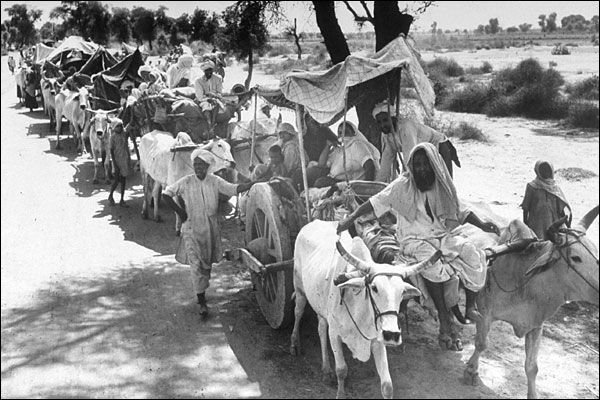On this day in 1947, Radcliffe line was drawn across Akhand Bharat, dividing to into Hindu majority India and Muslim majority Pakistan. It is a well-known fact that Radcliffe line was drawn by persons who had no knowledge of India’s history, geography or even ground realities.
They merely relied on the data points provided by census reports and used information pertaining to infrastructure to partition India. While the line more or less demarcated Hindu and Muslim majority areas accurately, there were cases where decisions proved controversial.
1. Punjab:
The province of Punjab had 53% Muslims, 30% Hindus and nearly 15% Sikhs as per 1941 census. Along with Bengal, it was one of the areas identified for partition into Hindu/Sikh and Muslim majority areas. While Eastern Punjab was mostly Hindu/Sikh, Western Punjab had a preponderance of Muslims. Radcliffe, therefore had to tread very carefully while partitioning Punjab.
a. Lahore
Lahore was the premier city of Punjab. Historically, it had been the capital of Sikh empire as well as a provincial capital of the Mughals. Hindus identified Lahore with the capital of Lord Ram’s son Lava. The city was dotted with Temples, Gurudwaras and Mosques. While Hindus and Sikhs dominated the Financial scene, Muslims made up a plurality of population both in Lahore city and the district. Initially, Radcliffe had planned to give the city to India, but later amended it to ensure that at least one major city should remain in Pakistan.
b. Amritsar
The city of Amritsar was particularly important to Sikhs as it houses the Golden temple. In 1941, 48% of the population of the city was Muslim as against Hindus/Sikhs making up 52% of the population. Amritsar district was 50% Muslim and only 48% Hindu/Sikh. It is believed that Amritsar was handed over to India as a compensation for Lahore which went to Pakistan.
c. Gurdaspur
Gurdaspur district had a slight Muslim majority with 51% Muslims. Initially, the district had been planned to be given to Pakistan. However, the final award brought the district into India, apart from Shakargarh tehsil which was transferred to Pakistan. While Amritsar’s dependence on Gurdaspur was claimed by Radcliffe as the reason why Gurdaspur was awarded to India, it is popularly believed that Mountbatten influenced the award in India’s favour, thereby keeping India connected to Jammu & Kashmir.
2. Sindh
Inspite of 25% of the province’s population being Hindu, Sindh was not partitioned into Hindu and Muslim states. To this day, desert tracts of Sindh bordering Rajasthan continue to have large Hindu populations. It is believed that Sindh was not partitioned to compensate Pakistan for the loss of Muslim majority, fertile districts in Punjab to India.
3. Bengal
Bengal and Punjab were identical in their communal divide, except that the divide was direct between Hindus and Muslims. 53% of Bengal’s population was Muslim, against 42% Hindus. Eastern half of Bengal was mostly Muslim while the Western half was mostly Hindu. Hindus dominated the cities while Muslims dominated the countryside.
a. Malda & Murshidabad
Malda & Murshidabad districts with overwhelming Muslim majorities were largely handed over to India, ostensibly to create a corridor to the Hindu dominated hills, which otherwise would be severed from West Bengal.
b. Khulna
The large district of Khulna with a slight Hindu majority was awarded to Pakistan. It is believed this was done to compensate Pakistan for the loss of parts of Malda and Murshidabad. Given Khulna’s dependence on the Muslim majority Jessore district, it would have been impossible to allocate Khulna to India without awarding parts of Jessore district too.
c. Chittagong Hill tracts
Chittagong Hill tracts had an overwhelming non-Muslim majority. 97% of its population was Buddhist/animist and yet the district was awarded to Pakistan. It is believed that while the Buddhists of the Hill tracts did not get representation in the Boundary commission, Pakistan loudly claimed that the only way to the hills was through Chittagong which was certain to end up in Pakistan. Also, the Indian side was possibly lacking in their endeavours to secure the Hill districts. When the award was announced and India realized that Chittagong Hill Districts had ended up in Pakistan, Sardar Patel was furious. But nothing could be done.
On the whole, Radcliffe award ended up pleasing neither India nor Pakistan. Countless Hindus and Sikhs and Muslims found themselves on the wrong side of the border. Massacres and population transfers on a scale never seen before inevitably resulted. 7 decades later, West Pakistan has been cleansed of its Hindu and Sikh heritage while Hindu minorities in Bangladesh find themselves besieged by Islamist elements. On the other hand, India has been kinder to its minorities who stayed back. Could a better line have been drawn? Perhaps. Could the resulting massacres and bloodshed been prevented? Maybe not.
